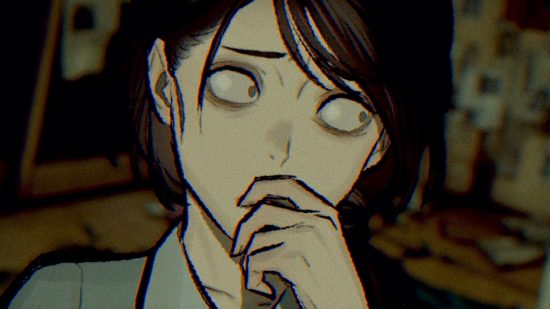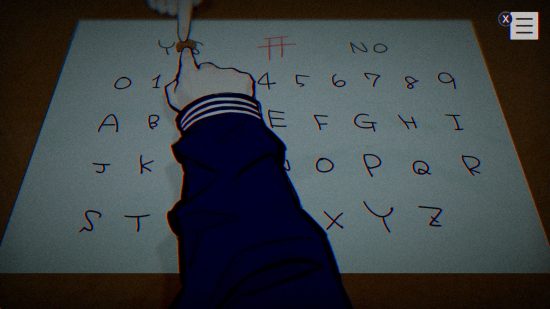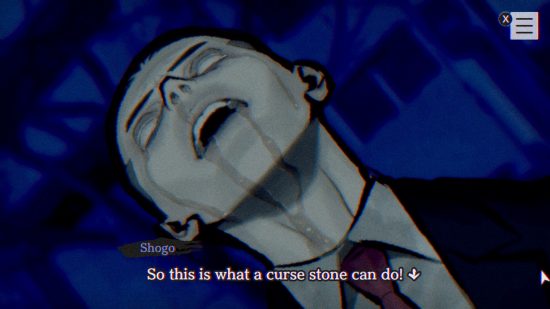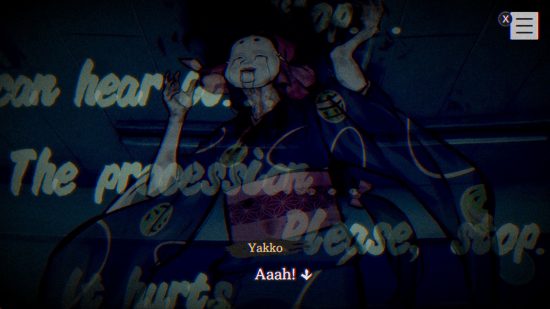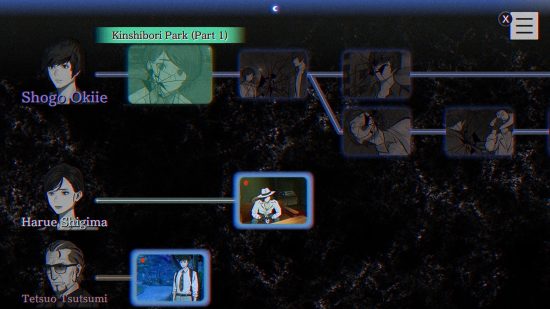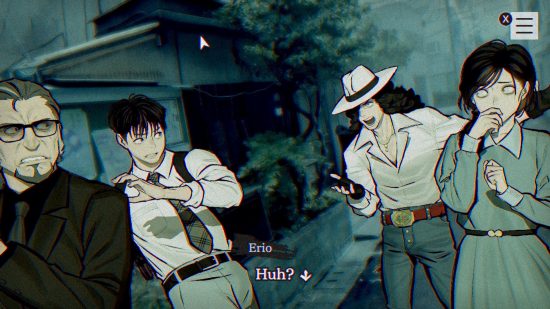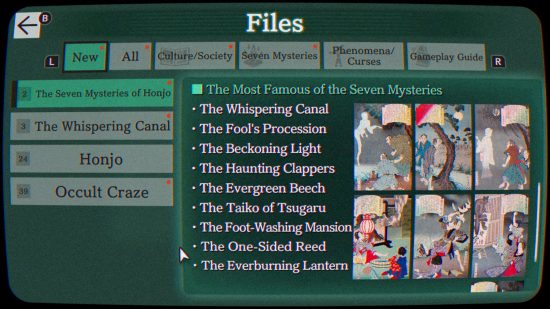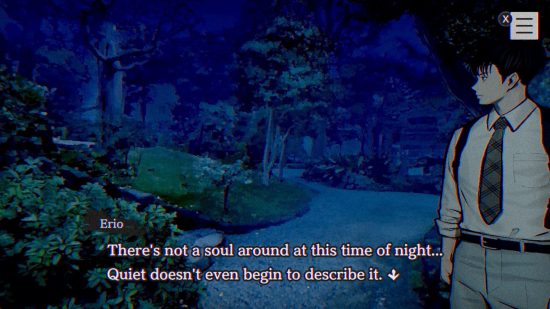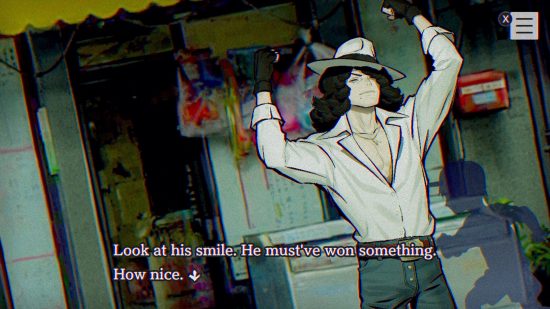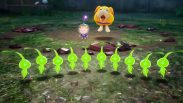Paranormasight: The Seven Mysteries of Honjo genuinely feels hand-tailored to my personal interests. I’ve long been a huge fan of visual novels, and when I’m not gaming, you’ll likely find me eagerly pawing through horror manga and webtoons – the more obscure and unusual, the better (if you’re interested in such topics, check out my feature on Crunchyroll’s Junji Ito anime over on our sister site, the Digital Fix). So when I heard of Square Enix’s upcoming mystery horror visual novel, I couldn’t wait to dive in and get my hands dirty. And hoo boy, is this a deliciously hand-dirtying treat.
I started playing it while lying in bed on a Friday night (I know, I’m such a party animal, aren’t I?) after a very long and exhausting week, looking for a little spot of spookiness to carry me off to dreamland. ‘I want to get an early night, so just half an hour,’ I told myself, ‘just to dip my toes in’. Fast forward to several hours later – the sun is rising but I’m still hunched over my Switch like a gremlin, promising myself ‘just one more chapter’. If that’s not a testament to the nail-biting, brain-infesting brilliance of this game, I’m not sure what is.
The gameplay of Paranormasight predominantly relies on a visual novel told through short, repeatable chapters. There are, of course, dialogue options – some of which are far more important than others – but you also have free rein with your cursor in most scenarios and must click on different items and surroundings to learn about them, click on characters to talk to them, or click on the think or recall buttons to have your character ponder the situation and piece elements together. This system is very similar to other interactive visual novels like Spike Chunsoft’s AI: The Somnium Files or Danganronpa games, and adds a real element of immersion to each location.
While the cursor sometimes feels a little clunky on Switch (I’ve never been a fan of moving a cursor with a joystick), Paranormasight includes one feature that often gets overlooked in Switch games – touch screen controls. You can tap, scroll, zoom, and more, all with a flick of your fingertip across the screen. Team that with the flawless Switch performance and the sheer joy of playing this game in bed or on the sofa as though you’re tucking into a good book, and I actually feel this game is most enjoyable on the Switch in handheld mode. I’m sure the PC version works just as well with a keyboard and mouse, but the portability is a massive draw with this one.
I’d relay the core of the narrative, but telling you the story in a visual novel is as much a sin as telling you how to solve every puzzle in a puzzle game. Instead, I’ll lay down the groundwork. But, before we dive in, I want to highlight that the game deals with some very dark topics, including suicide, abuse, violence, and bloodshed, so please keep that in mind before playing and heed the mature content warning on the store page.
The core story of Paranormasight revolves around a series of urban legends known as the Seven Mysteries of Honjo, each of which is tied to a curse. One fateful night during the late 20th century, the Feast of Shadows descends upon the Sumida Ward of Tokyo, Japan, temporarily boosting the spiritual energy of the area, and triggering the Seven Mysteries of Honjo’s ‘curse echoes’ to turn a handful of people into ‘curse bearers’.
Each curse has a set of conditions that must be met before a curse bearer can use their curse on a victim, but all have fatal results. When a curse bearer kills someone with their curse, their curse stone (an old netsuke carving imbued with the power of the curse) gathers soul dregs. When the curse stone has enough soul dregs, the curse bearer can, supposedly, use it to perform the Rite of Resurrection to bring any one person back from the dead. But, more often than not, you mess with a curse, you end up in a hearse.
The Seven Mysteries of Honjo are based on real legends from the Japanese Edo period (find out more about these tales in this brilliant article on the Seven Wonders of Honjo). There are more than seven mysteries, however – as with the real Seven Wonders, the seven is purely nominal, chosen due to the mystical significance of the number. You can read about each of the Seven Mysteries from the in-game files, and even view Kuniteru Utagawa’s beautiful paintings.
After you encounter the curse tied to each of the Mysteries, the files expand to include details of its cursed power, a picture of its curse stone, the tale of its resentful memory, and the image of its curse echo.
I believe the resentful memories are original to this game, but they maintain the same atmosphere as the traditional Edo-era stories, and the designs of both the curse stones and the curse echoes are absolutely brilliant. From the anguished, melting face of the Haunting Clappers’ curse echo to the floating, severed head of the Ever burning Lantern’s curse echo, I’m overcome with a sick sense of delight every time I get a glimpse of one of the appallingly awe-inspiring apparitions.
The game features multiple story paths, all taking place concurrently. Initially, you take control of Shogo Okiie, a young office worker who sets out to meet his occult-obsessed friend late one night. After you see Shogo Okiie’s story through to completion in two different ways, you gain access to several other narratives through the story chart.
This is a relatively common mechanic in visual novels, especially dating sim or otome games, though you usually have several character paths to choose from initially, then unlock some fancier ones when you reach a certain number of endings. However, I feel Paranormasight railroading you into Shogo’s story first and introducing you to the other characters by proxy is a brilliant approach that helps you form a stronger understanding of the narrative before getting too tangled up in its web.
And boy, does that web get tangled. All of the stories are deeply interwoven, and you often have to suspend one narrative and complete events in another before you can progress. Through this system, the game acknowledges you as an omnipresent voyeur peering into the tale from the outside, encouraging you to take information from one story and feed it to a character in another.
Should you allow a protagonist to die, a mysterious storyteller pulls you out to have a little chat, giving you hints about where you went wrong and highlighting your unique vantage point. There are definitely meta elements that break the fourth wall in some ways, but Square Enix implements them so seamlessly that it feels entirely rewarding.
There’s a certain level of trial and error required in some areas, where the protagonist must die to a curse in order to reveal its nature to you as the player. Avoiding these curses may be something as simple as refusing to turn around, but as you progress, they become more of a puzzle to solve.
I won’t spoil anything, but there’s one particular curse I was stuck on for three death loops, laying in my bed at 3am refusing to be beaten by it. Then I remembered the words of that mysterious storyteller, and I realised that the in-game settings can actually play a part in avoiding curses. This gave me a sick sense of joy as I tricked that blasted curse bearer, rebuffed their curse, and then claimed their soul dregs for myself.
Paranormasight’s writing is sublime. It’s brilliantly translated (which, surprisingly, is not that common in English versions of visual novels), wonderfully detailed, full of intriguing little details to mull over, and even displays a nice sprinkling of dark humour – especially in the conversations between detectives Jun Erio and Tetsuo Tsutsumi.
As you progress through the web of stories from different perspectives, you uncover little tidbits of information that shine a light on other experiences you’ve been through, with a commendable sense of thoughtfulness in how each of the concurrent narratives weave together and complement each other. Plus, with so many story paths to explore and grizzly endings to meet, the game’s length is easily comparable with a full novel.
The character designs in Paranormasight are wonderfully emotive and dynamic, even though they’re predominantly static sprites. Each character has a range of poses and expressions, and their eyes and mouths move as they talk. Though they’re clearly 2D illustrations with bold, dry-brush-style outlines, they synergise perfectly with their backgrounds, and their outfits and hairstyles fit well with the era.
In terms of UI, the font is clear and bold, white with a black outline to make it easy to read against the dark backgrounds. The speaker’s names are different colours, which help you figure out which character is talking while you’re still working out who’s who, and significant names, places, or other things of interest mentioned in dialogue are written in blue or yellow.
When you learn something new, you get a pop-up telling you that your files have an update, and you can choose to go straight into the files section to check it out, or take a look at the updated info in the ‘new’ files tab later. This helps ensure that you never miss a significant hint or link to something you’ve previously learnt about.
Both the design and narrative of Paranormasight offer a super fascinating blend of real Japanese history, culture, legends, and locations, with fictional narratives woven in. The informative files blend reality, history, legend, and fiction seamlessly, and found me setting out to further research topics that I previously only had a surface understanding of.
As someone who wrote papers on the trans-Atlantic impact of spiritualism and the occult on late 19th-century American and English literature, it’s been fascinating to further my understanding of how Western occultism and mysticism began to blend with Eastern concepts of the supernatural in the 20th-century – and it’s truly admirable how informative this game is, while still remaining entertaining and purely original in its own right.
To amplify this further, each in-game location is made up of a 360 panoramic image dome based on photos of the real-life locations back in the early 80s. This is a truly fascinating art direction, adding to both the realistic grounding of these bizarre and otherworldly tales and to the claustrophobia of each location as you stand stationary at the heart of a spinning firmament.
I would have loved there to be full Japanese voice acting, or even the occasional grunt or sigh. However, for such a low price I feel far from cheated by its absence (especially considering many visual novels go for near triple-A prices these days), and if anything, the silence only interrupted by blustering winds or distant ticking ultimately adds to the unnerving vibes and enhances the effect of the well-timed musical overtures. Plus, the game’s soundtrack is brilliant and fits well with both the themes and era of the game.
To me, Paranormasight is a perfect example of how to make a visual novel engaging, and it stands toe to toe with some of the best titles in Spike Chunsoft’s catalogue. It’s a truly haunting experience that pulls you into its world so expertly, you’ll be unable to look away. If you’re a fan of Danganronpa, AI: The Somnium Files, or anything to do with urban legends, the supernatural side of Japanese culture, and the mysteries of the occult, then I implore you to give this one a try – I promise that you won’t regret it.
For more nail-biting narratives and soulful stories, check out our guides to the best visual novel games and otome games. Or, if you’re chomping at the bit for a new mystery to sink your teeth into, head over to our list of the best mystery games.
Paranormasight Switch review
Paranormasight is a masterpiece. With a dizzying web of interwoven narratives, an uncanny ability to blur the lines of fact and fiction, and a thoroughly thrilling atmosphere, it’s truly the gold standard of engaging visual novels and a must for anyone fascinated by the deliciously dark world of the supernatural and the occult.
